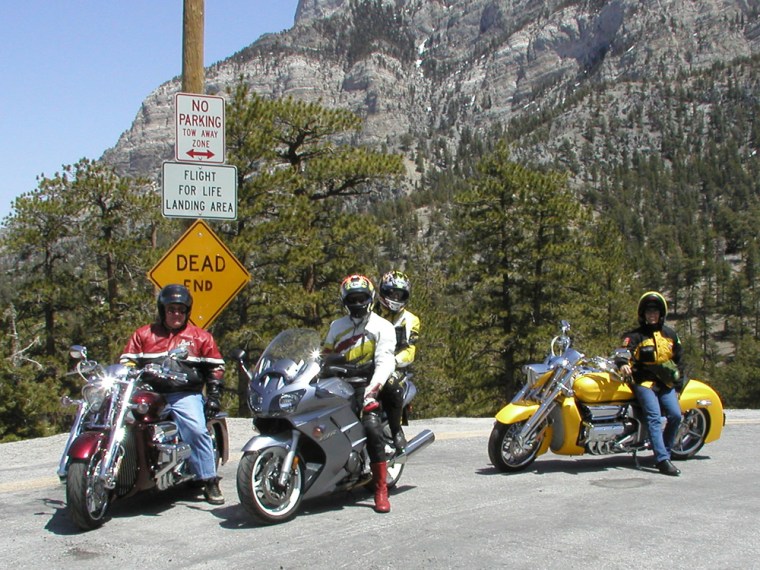Jim Lattimore, of Franklin, Tenn., has ridden over 800,000 miles on motorcycles in 74 countries over a span of nearly five decades. He still owns 14 bikes. But he’s 69, now.
“My reactions, admittedly, and I hate to say this, are not what they used to be,” he told NBCNews.com.
Reaction times, dexterity and physical conditioning all decline with age. But about 15 years ago, motorcycling, which requires all these, became increasingly popular among people over 50 who were rediscovering their inner Wild One, cite the authors of a study being released today by Brown University epidemiologists in the journal Injury Prevention.
Using data from the National Electronic Injury Surveillance System, which monitors a representative sample of hospital emergency departments, the researchers found roughly 1.4 million injuries to motorcyclists over age 20 between 2001 and 2008. Eighty-five percent of cases were male.
Most injuries occurred in younger people, but the number of cases among people over 50 increased by 247 percent, from 4,352 to 15,107. While the number of injuries increased in all age groups, the over-50 riders were on a steeper curve by far.
Just as importantly, older riders tended to be injured more severely. They had the highest rate of hospitalization. Over one-third, 35 percent, required a stay. They also had the highest rate of fractures and internal organ (including head and neck) damage.
“If you’re looking at the segment of motorcyclists who are injured and the types of injuries sustained among those who visit emergency departments,” lead author Tracy Jackson, a Phd student, explained, “older adults are a greater percentage of the severe injuries.”
For the purpose of the study, Jackson said, she defined “severe” as fractures and dislocations, or any kind of internal organ injury. Contusions, lacerations, and abrasions were classified as non-severe.
The data the team used did not include fatalities. But in the study, Jackson cites National Highway Traffic Safety Administration numbers to point out that in 2001, 4.46 percent of fatal motorcycle injuries “were sustained by individuals 60 years and older.” By 2008, it was 10 percent. Fatalities among those aged 40-59 increased from 37.14 percent to 43.26 percent of all motorcyclist deaths.
From a public health standpoint, Jackson said, “it’s interesting to note that the number of injuries in older riders is increasing every five years, it seems like. More people are engaging in motorcycle riding and because of this, you want to make sure that population is properly trained and wearing proper gear.”
That’s exactly what Lattimore and his wife, Joey, who also rides, stress to anybody who asks them about taking up motorcycling for the first time or after a long layoff.
“I tell them the first thing to do is go take a riding course, a formal course, not one taught by your brother-in-law,” he said with a laugh. “I am adamant about that. Both Joey and I, even with all the riding we’ve done, we take some kind of refresher course every year.” Just like pilots have to undergo regular training, no matter how long they’ve been flying, Lattimore thinks motorcyclists should do the same. “It’s too easy to fall into bad habits,” he said.
That’s what the motorcycle industry, painfully aware of its reputation for danger, encourages. The major manufacturers established the Motorcycle Safety Foundation which develops rider courses and training materials. Its mission statement, according to the group’s website, is to “make motorcycling safer and more enjoyable by ensuring access to lifelong quality education and training for current and prospective riders, and by advocating a safer riding environment.”
But Lattimore has also trimmed down his bike collection from 24. His old “crotch rockets" -- like a very fast Suzuki Hyabusa -- are gone. “I used to ride really, really, stupidly fast,” he said. Most of his riding time is now spent on a BMW R1200, a cruiser. And, partly to accommodate his slower reaction times, he rides slower. He doesn’t always wear the full complement of protective gear, like hip, knee, and spine pads, but he never rides without a helmet even where state law permits.
“A helmet is a must, all the time,” he said. “Head-on-pavement gets you killed.”
Despite the accommodations to age, Lattimore, who’s retired from the accounting firm he founded, has no intention of giving up riding. After all, he said, in all those miles during all those years, he’s only had one real accident, in the Chilean Andes. Another motorcyclist crashed into him.
Brian Alexander (www.BrianRAlexander.com) is co-author, with Larry Young Ph.D., of "The Chemistry Between Us: Love, Sex and the Science of Attraction," (www.TheChemistryBetweenUs.com), now on sale.
